Traditions from all over Maharashtra merge to welcome Gauri in Pune
People from various parts of Maharashtra have settled in Pune and have brought along their traditions and rituals for worshipping Gauri. The way the Goddess is bedecked or what is offered as ‘naivedya’ varies from communities across the state. here are a few..
Incessant rains did not dampen the spirit of the devotees who brought home ‘Gauri’ on Tuesday. The joy and fervour was evident among citizens especially women who have been busy since morning cleaning up homes and making last minute preparations to welcome Gauri.
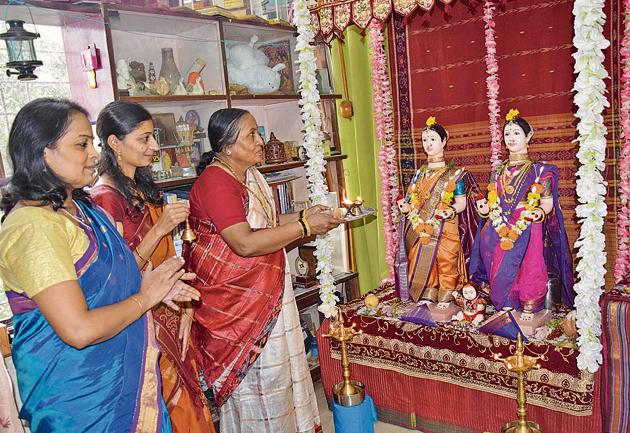
“Gauri often known as Jehstha (elder) and Kanistha (younger) are hailed as Ganesha’s sister,” informs Arundhati Prabhune, a resident of Chinchwad. It is like homecoming for the daughters, who come back to their mother’s place for a festival. They stay three days. “On the first day, the ‘muhurat’ (auspicious time) is post noon and then, we begin setting up the Gauris,” she adds.
While most of the Pune homes have standing figures of Gauri, it is the decoration which gets more precedence. Most of the times, the Gauri is envisioned as the Goddess of forest, so one can see her surroundings all bedecked with flowers and shrubs, while some paint, so she is depicted standing in a lotus pond or even in a grand avatar.
Television serials, too, lend to the tradition. The ‘Jai Malhar’ style for decoration is very popular and women love to show off their Gauris dressed in all the finery, fit for a queen.
They all belong to various parts of Maharashtra and yet destiny, work or marriage has brought them to Pune. Their traditional way of celebration of Gauri is seen in how the goddess is bedecked or in what they offer the Goddess as ‘naivedya’ (offering to God).
Deity dressed up in special Kathpadar saree
In the Prabhune home, the Gauris are standing. “We take immense pleasure in dressing them in brand new Kathpadar sarees. They visit their maternal home for three days during the Ganesh Festival.
The first day is called the ‘agaman’, where we serve her bhakri and bhaji, and since she has travelled, she prefers a simple meal. One of them also brings her baby with her.
On the second day, it is a feast of ‘panch pakwanna’ (five sweets) namely puranpoli, shrikhand, shakhar bhaat, gulab jamun, seviya kheer. Along with these sweets, 16 different seasonal vegetables are cooked for her. ‘Oti bharni’ is performed and then, ‘haldi kumkum’ is done for all the invited women.
On the third day, Gauris return home. As her blessing, the women in the house wear a yellow thread around their neck,” said Supriya Prabhune.
Non-veg food offered to warrior Goddess
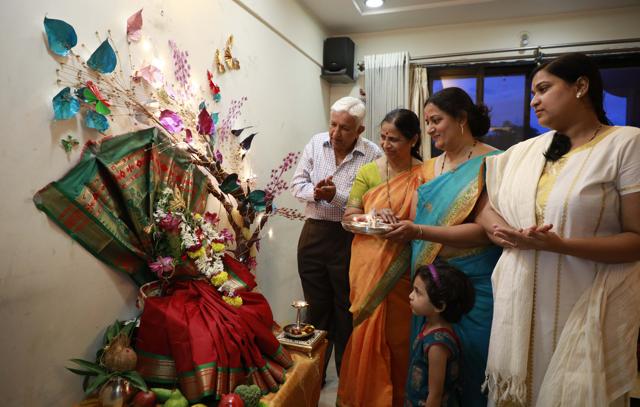
Geetanjali Pradhan, a resident of Kothrud, follows the traditions laid down for the Chandraseniya Kayastha Prabhu or CKPs as they are commonly known.
“We follow the footsteps of what our elders have taught us. So, we pick up seven khade (stones) from a river bank, clean it with ‘panchamrita’, then, walk back home along with Terdachi zade (a monsoon green plant with pink, purple colour flowers).
The footsteps are stamped in vermillion (kumkum). We also bring her home with offerings of wild fruits. We follow the Goddess of the forest and most of the people who bring these plants home belong to the Maval area. Our Gauri represents greenery and is the epitome of the beauty of this season.
Together with the stones, and plants, we dress her up in all the finery and jewellery without a mask. The first day, she is offered green leafy vegetable called ‘hirwa math’ with Bhakri and sweet sheera, but on the second day, which is important, we offer non-vegetarian food.
In our offerings to her, we offer mutton with bhakri and bhaji. We consider Gauri to be a warrior, and a forest Goddess, hence, you serve what you get in the jungle, where meat is preferred. We have only one Gauri. On the third day, we offer kanola, kheer and puri,” said Geetanjali.
Gold-plated masks are a tradition here
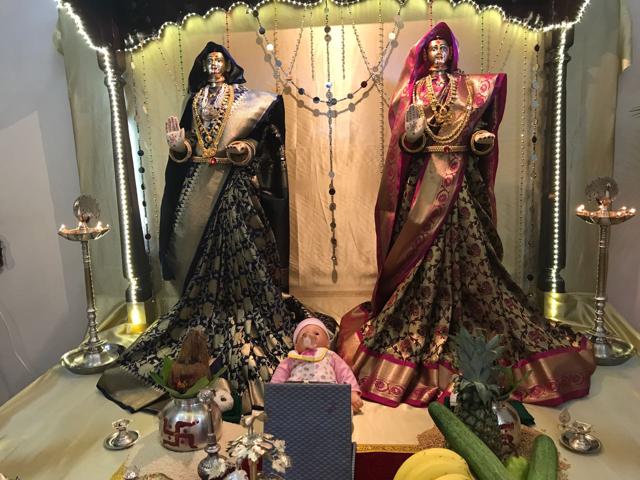
Then, there are generations of Punekars who have a tradition to carry like Sangeeta Abhijeet Panhale, a resident of Bhavani Peth. Shankar Ramchandra Panhale came to Pune in 1888 with his mother from Ambegaon.
He started an auctioneering firm in 1905 on MG road. “The mukhauta (masks) were originally made up of copper and were with the family before 1888. Later in 1936 Sonubai Panhale (wife of Raosaheb) vowed to have it plated with gold if she gave birth to a son. She gave birth to a boy next year itself and so, now the masks are gold plated. We are the fourth generation carrying out this tradition,” said Sangeeta.
‘Parvati’ invited as a daughter

Swapna Punekar is from Kolhapur but she performs the puja according to her husband’s family tradition from Solapur. “We have a standing Gauri at my home. We believe Goddess Parvati has come as our daughter and she has come to meet Ganesha to bless him.
“We worship the Tulsi plant and mukhavate (mask) near a Tulsi vrindavan and offer ‘sevai kheer’ to her. We call our two Gauris - Ganga and Gauri. We offer her ‘jawar bhakri’ and ‘methi sabji’ along with telachi (roti made with jaggery, groundnut powder as stuffing in wheat).
“Grains and some vegetables are used in decoration called Vasa. Next day in the morning, we offer faral of laddo, chakali, and karanji. We also worship Lord Shiva along with Gauri and offer naivedya of puranpoli, four to five vegetables, salad, and aloo wadi chatani.
“Next day, we make a white thread dipped in turmeric of 16 knots, 11 knots and 5 knots which are then offered as prasad to the women in the family,” said Swapna.
Goddess invoked in pebbles
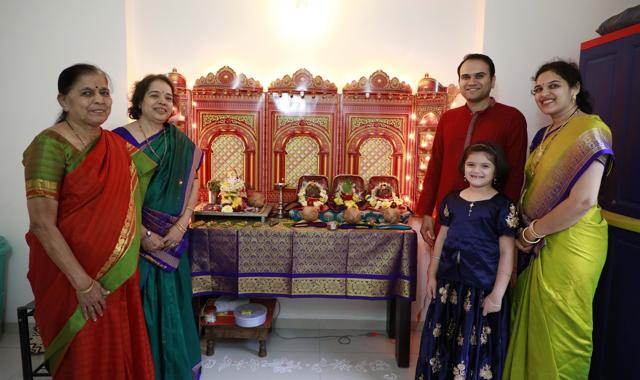
In Maitreyee Godbole’s family in Bhavdan, Gauri is treated as Ganesha’s mother. They bring in khadyachya Gauri, which means small pebbles from the river bank and walk her through each room.
“This is so that Lakshmi or Gauri enters the home along these steps. We prepare a lot of sweets like ladoo, shankarpali, chakli, karanji. This type of Gauri is usually seen among Kokanastha Brahmins.
“On the first day, it's Gauri puja when we welcome Goddess Parvati and worship her. On the second day, we invite married women to have lunch in our home,” said Maitreyee.
A Gauri which displays emotion
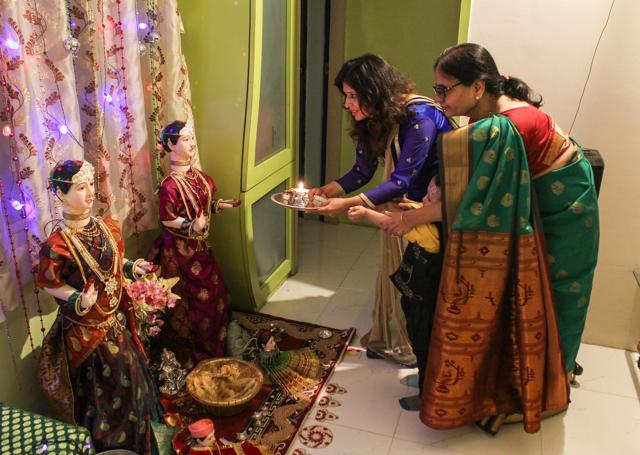
For Mona Pandit Dahibhate, the Gauri puja in both her maternal home and in-laws home, is very traditional. “Gauri in my mother’s place is more from Pune with metal masks while the Gauris at my in-laws are big and their masks are made out of clay. This kind of worship or puja is from the Marathwada region,” said Mona.
One can actually see the facial changes as the day proceeds, for Mona believes that there is a hint of a smile on the second day of worship with an offering of puranpoli.
On the third day, which is the departure, the face changes slightly and is less shiny, according to Mona. She believes the Gauris represent the emotions that married women go through when they leave their parent’s home.



